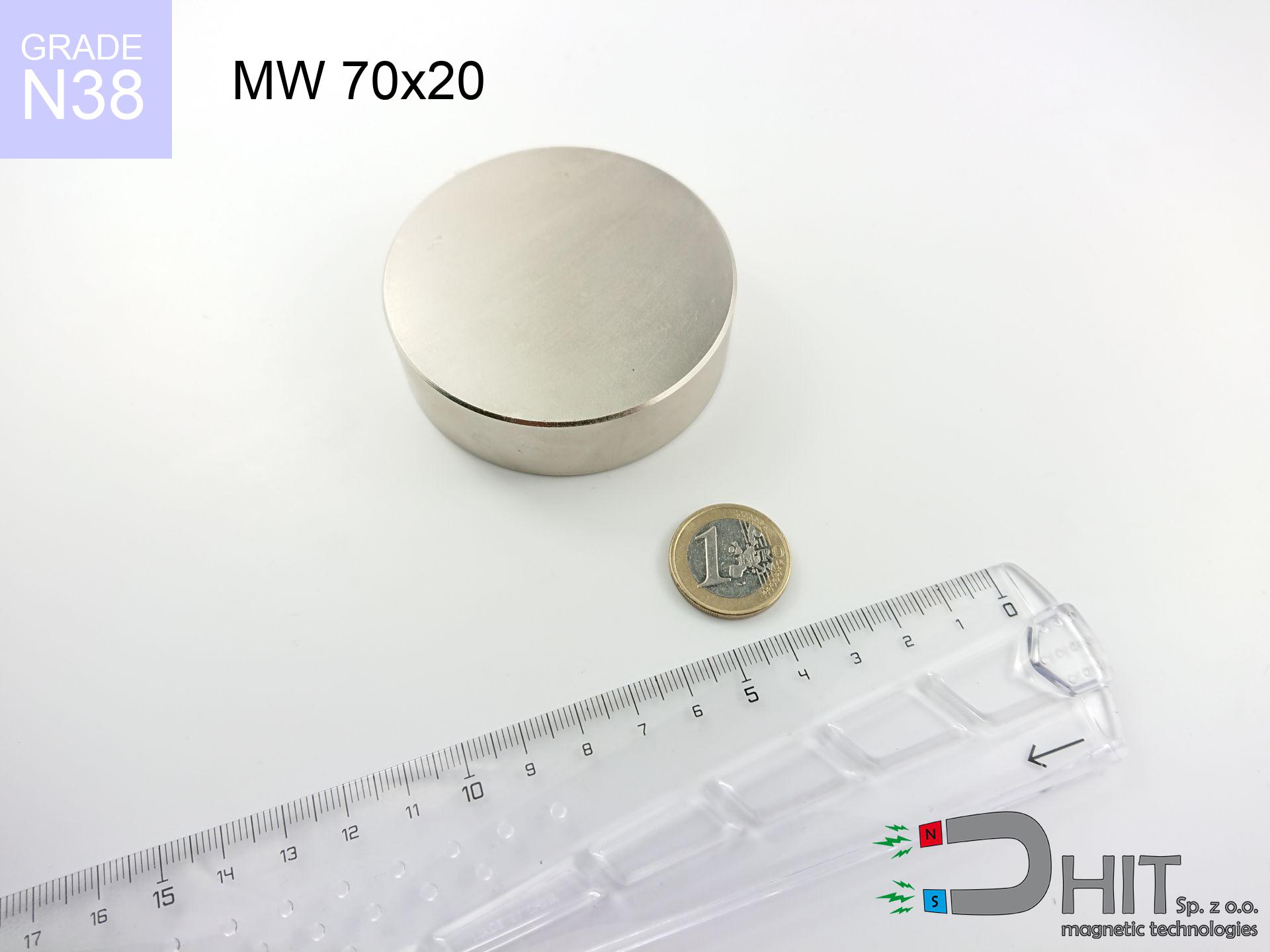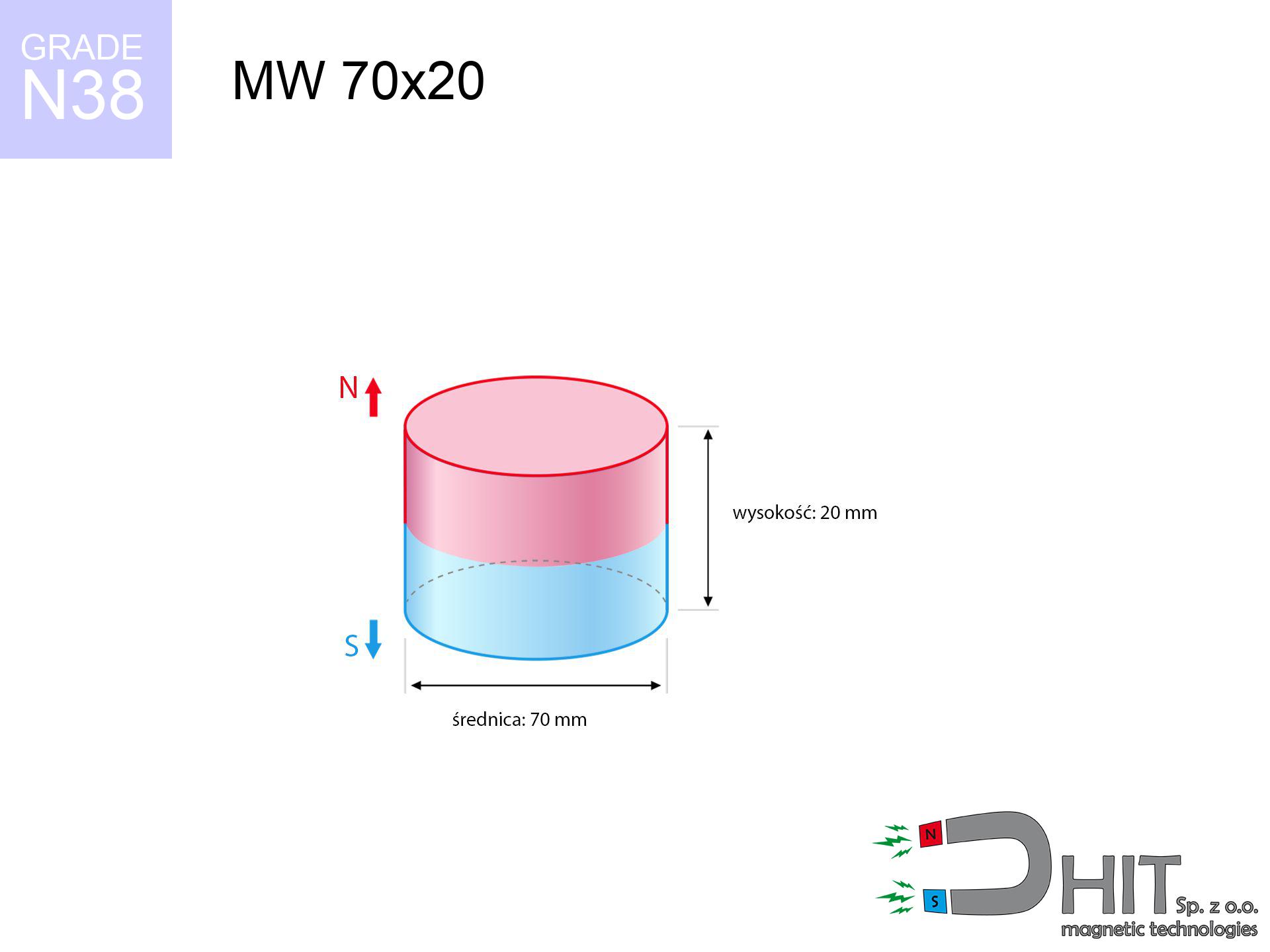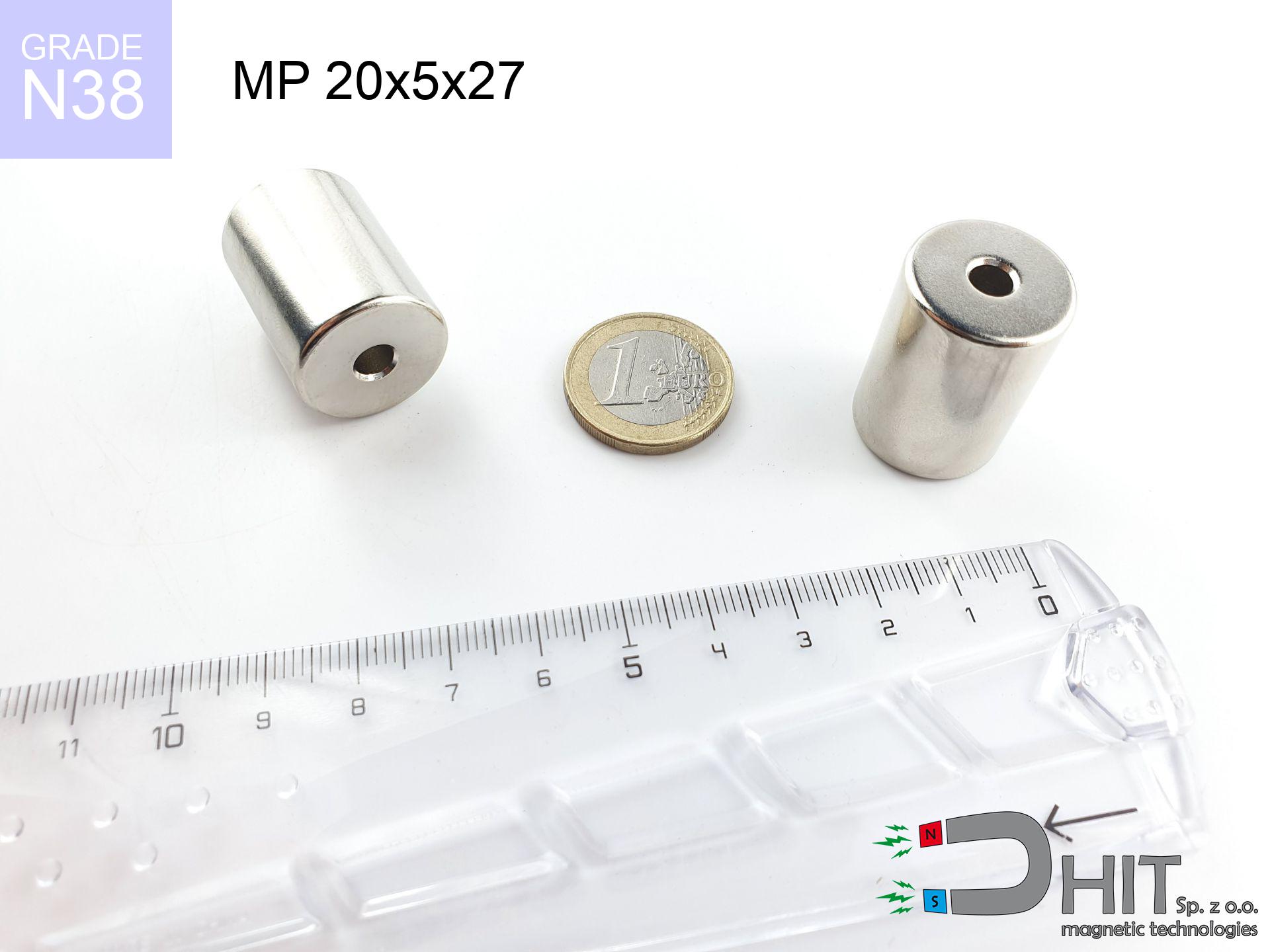MW 70x20 / N38 - cylindrical magnet
cylindrical magnet
Catalog no 010095
GTIN: 5906301810940
Diameter Ø [±0,1 mm]
70 mm
Height [±0,1 mm]
20 mm
Weight
577.27 g
Magnetization Direction
↑ axial
Load capacity
77.41 kg / 759.13 N
Magnetic Induction
307.57 mT
Coating
[NiCuNi] nickel
239.85 ZŁ with VAT / pcs + price for transport
195.00 ZŁ net + 23% VAT / pcs
168.83 ZŁ net was the lowest price in the last 30 days
bulk discounts:
Need more?Not sure about your choice?
Contact us by phone
+48 22 499 98 98
alternatively let us know by means of
form
our website.
Weight and appearance of a magnet can be reviewed on our
modular calculator.
Same-day processing for orders placed before 14:00.
MW 70x20 / N38 - cylindrical magnet
Magnetic properties of material N38
Physical properties of NdFeB
Shopping tips
Moreover, even though neodymium is part of the strongest magnets, they are prone to corrosion in humid environments. Therefore, they are coated with a coating of nickel to increase their durability. It's worth noting that NdFeB neodymium magnets are about 13% lighter than SmCo magnets and, despite their power, easily break, which requires care during their handling. For this reason, any mechanical processing should be done before they are magnetized.
In terms of safety, there are many recommendations regarding the use of these magnets. It is advisable to avoid their use in acidic, basic, organic environments or where solvents are present, as well as in water or oil. Additionally, they can distort data on magnetic cards and hard drives, although data deletion using a neodymium magnet is not always certain.
In terms of properties in different environments, neodymium magnets are sensitive to corrosion, especially in conditions of high humidity. Therefore, they are often coated with coatings, such as nickel, to shield them from external factors and extend their lifespan. Temperatures exceeding 130°C can cause a loss of their magnetic properties, although there are specific types of neodymium magnets that can tolerate temperatures up to 230°C.
As for potential dangers, it is important to avoid using neodymium magnets in acidic conditions, basic environments, organic or solvent environments, unless they are properly protected. Additionally, their use is not recommended in water, oil, or in an environment containing hydrogen, as they may lose their magnetic strength.
Advantages and disadvantages of neodymium magnets NdFeB.
In addition to their immense magnetic power, neodymium magnets offer the following advantages:
- They retain their full power for around 10 years – the loss is just ~1% (in theory),
- They protect against demagnetization induced by ambient electromagnetic environments effectively,
- By applying a reflective layer of gold, the element gains a modern look,
- Magnetic induction on the surface of these magnets is very strong,
- These magnets tolerate high temperatures, often exceeding 230°C, when properly designed (in relation to build),
- The ability for precise shaping and adjustment to specific needs – neodymium magnets can be manufactured in a wide range of shapes and sizes, which amplifies their functionality across industries,
- Key role in cutting-edge sectors – they serve a purpose in computer drives, electromechanical systems, medical equipment or even high-tech tools,
- Compactness – despite their small size, they generate strong force, making them ideal for precision applications
Disadvantages of NdFeB magnets:
- They are fragile when subjected to a heavy impact. If the magnets are exposed to physical collisions, it is suggested to place them in a protective enclosure. The steel housing, in the form of a holder, protects the magnet from breakage , and at the same time strengthens its overall resistance,
- High temperatures may significantly reduce the strength of neodymium magnets. Typically, above 80°C, they experience permanent weakening in performance (depending on height). To prevent this, we offer heat-resistant magnets marked [AH], capable of working up to 230°C, which makes them perfect for high-temperature use,
- They rust in a wet environment. For outdoor use, we recommend using encapsulated magnets, such as those made of plastic,
- Limited ability to create threads in the magnet – the use of a mechanical support is recommended,
- Health risk related to magnet particles may arise, when consumed by mistake, which is significant in the family environments. Additionally, minuscule fragments from these devices might disrupt scanning if inside the body,
- High unit cost – neodymium magnets are pricier than other types of magnets (e.g., ferrite), which increases the cost of large-scale applications
Best holding force of the magnet in ideal parameters – what affects it?
The given strength of the magnet corresponds to the optimal strength, measured in ideal conditions, specifically:
- with the use of low-carbon steel plate acting as a magnetic yoke
- of a thickness of at least 10 mm
- with a polished side
- in conditions of no clearance
- with vertical force applied
- under standard ambient temperature
Practical aspects of lifting capacity – factors
The lifting capacity of a magnet depends on in practice key elements, from primary to secondary:
- Air gap between the magnet and the plate, since even a very small distance (e.g. 0.5 mm) causes a drop in lifting force of up to 50%.
- Direction of applied force, because the maximum lifting capacity is achieved under perpendicular application. The force required to slide the magnet along the plate is usually several times lower.
- Thickness of the plate, as a plate that is too thin causes part of the magnetic flux not to be used and to remain wasted in the air.
- Material of the plate, because higher carbon content lowers holding force, while higher iron content increases it. The best choice is steel with high magnetic permeability and high saturation induction.
- Surface of the plate, because the more smooth and polished it is, the better the contact and consequently the greater the magnetic saturation.
- Operating temperature, since all permanent magnets have a negative temperature coefficient. This means that at high temperatures they are weaker, while at sub-zero temperatures they become slightly stronger.
* Holding force was checked on a smooth steel plate of 20 mm thickness, when a perpendicular force was applied, whereas under attempts to slide the magnet the load capacity is reduced by as much as 75%. Additionally, even a small distance {between} the magnet’s surface and the plate lowers the holding force.
Precautions
Keep neodymium magnets away from TV, wallet, and computer HDD.
The strong magnetic field generated by neodymium magnets can damage magnetic media such as floppy disks, video tapes, HDDs, credit cards, magnetic ID cards, cassette tapes, or other devices. They can also damage devices like video players, televisions, CRT computer monitors. Remember not to place neodymium magnets close to these electronic devices.
Neodymium magnets can attract to each other due to their immense internal force, causing the skin and other body parts to get pinched and resulting in significant swellings.
Magnets attract each other within a distance of several to around 10 cm from each other. Remember not to put fingers between magnets or alternatively in their path when attract. Magnets, depending on their size, are able even cut off a finger or alternatively there can be a significant pressure or a fracture.
The magnet is coated with nickel. Therefore, exercise caution if you have an allergy.
Studies show a small percentage of people have allergies to certain metals, including nickel. An allergic reaction often manifests as skin redness and rash. If you have a nickel allergy, you can try wearing gloves or simply avoid direct contact with nickel-plated neodymium magnets.
Keep neodymium magnets away from people with pacemakers.
In the case of neodymium magnets, there is a strong magnetic field. As a result, it interferes with the operation of a heart pacemaker. However, if the magnetic field does not affect the device, it can damage its components or deactivate the device when it is in a magnetic field.
Dust and powder from neodymium magnets are flammable.
Avoid drilling or mechanical processing of neodymium magnets. Once crushed into fine powder or dust, this material becomes highly flammable.
Neodymium magnets are the strongest magnets ever invented. Their strength can surprise you.
Familiarize yourself with our information to correctly handle these magnets and avoid significant injuries to your body and prevent damage to the magnets.
Neodymium magnets are known for their fragility, which can cause them to shatter.
Magnets made of neodymium are fragile as well as will shatter if allowed to collide with each other, even from a distance of a few centimeters. They are coated with a shiny nickel plating similar to steel, but they are not as hard. At the moment of connection between the magnets, tiny sharp metal fragments can be propelled in various directions at high speed. Eye protection is recommended.
Neodymium magnets can demagnetize at high temperatures.
Despite the fact that magnets have been observed to maintain their efficacy up to temperatures of 80°C or 175°F, it's essential to consider that this threshold may fluctuate depending on the magnet's type, configuration, and intended usage.
Magnets should not be treated as toys. Therefore, it is not recommended for children to have access to them.
Remember that neodymium magnets are not toys. Be cautious and make sure no child plays with them. In the case of swallowing multiple magnets simultaneously, they can attract to each other through the intestinal walls. In the worst case scenario, this can lead to death.
Keep neodymium magnets as far away as possible from GPS and smartphones.
Magnetic fields generated by neodymium magnets interfere with compasses and magnetometers used in navigation, as well as internal compasses of smartphones and GPS devices.
Pay attention!
Please see the article - What danger lies in neodymium magnets? You will learn how to handle them properly.









